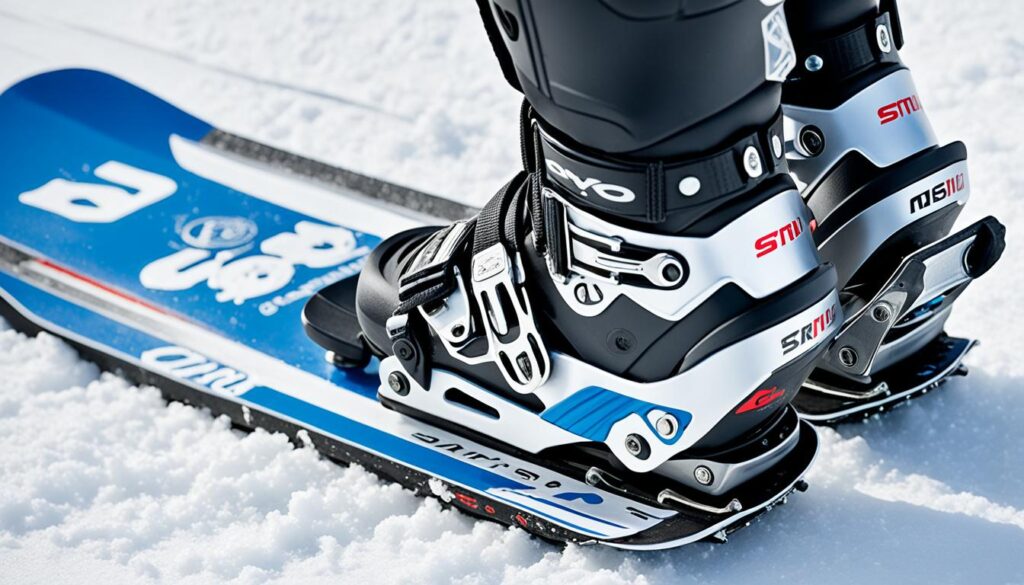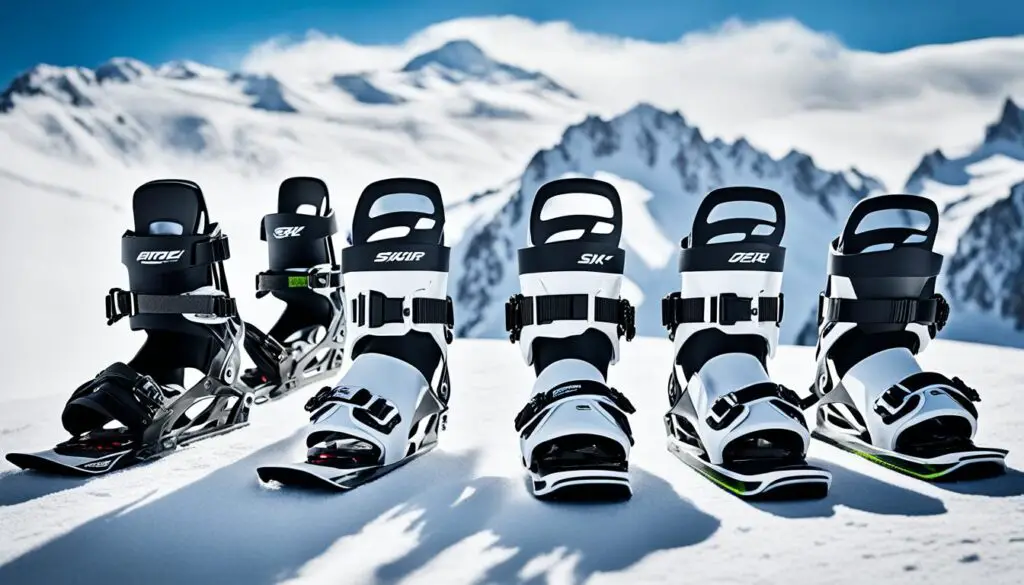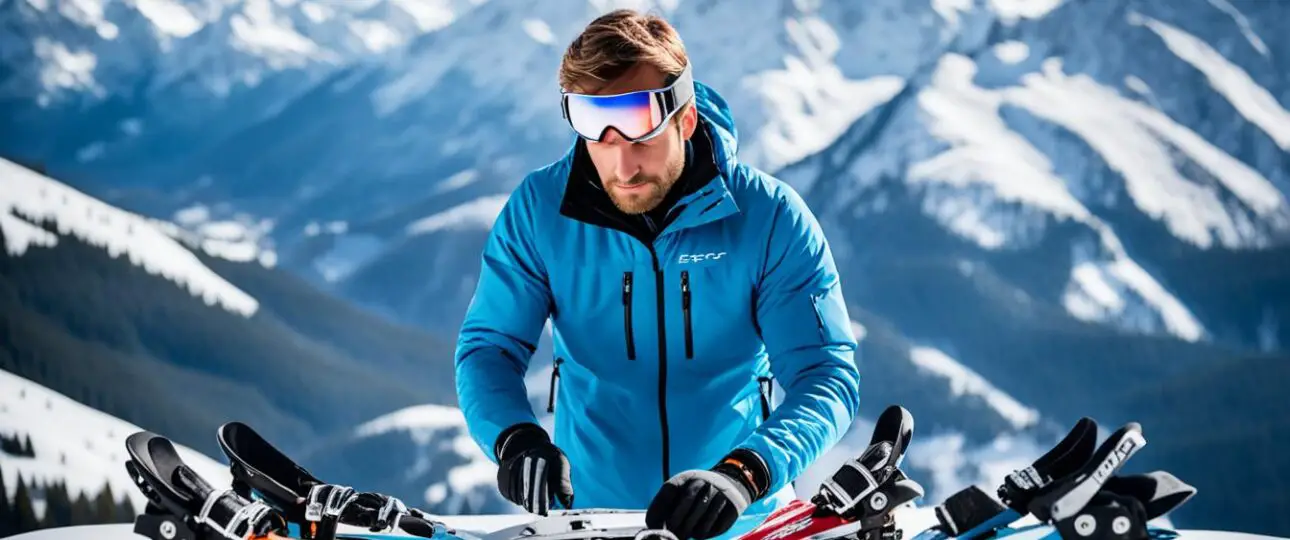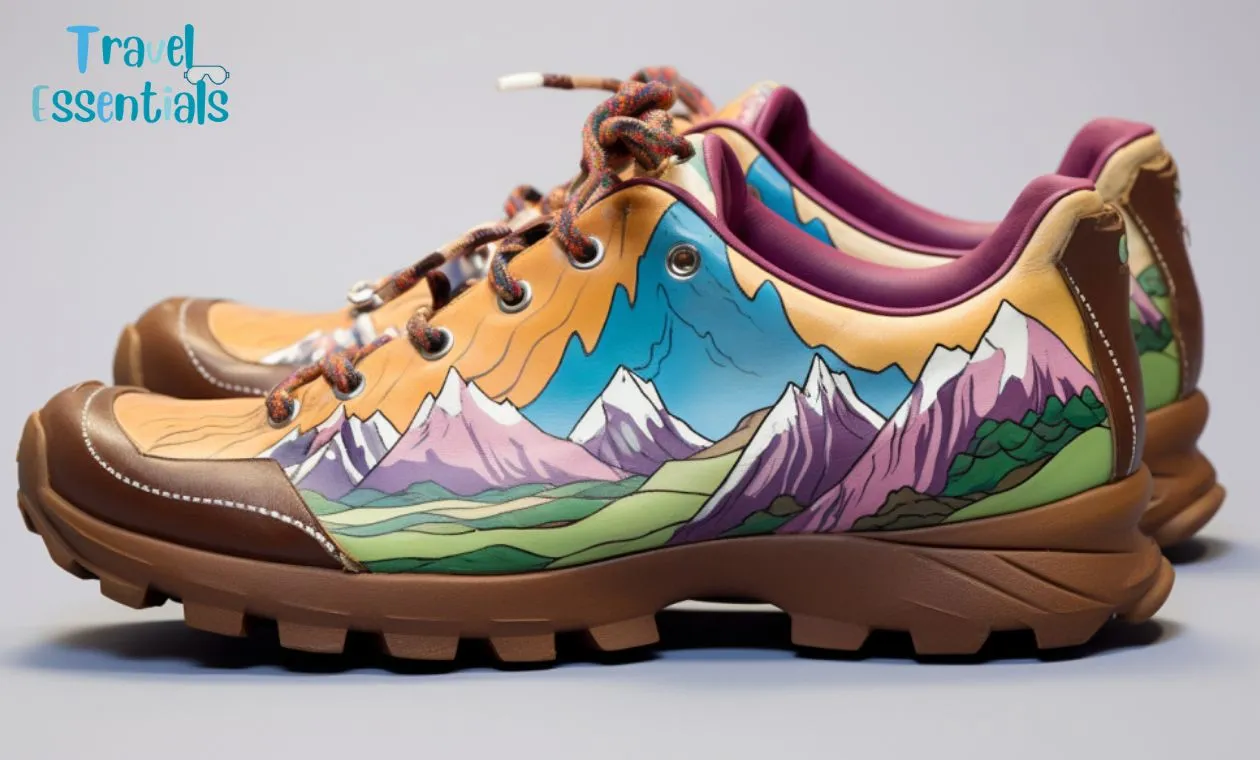Did you know that ski bindings are responsible for releasing your boots in the event of a fall, helping to prevent serious injuries? These small yet critical components play a crucial role in ensuring your safety and performance on the slopes. But with so many options available, how do you choose the right ski bindings for your needs?
In this comprehensive guide, we will walk you through the process of selecting ski bindings, covering everything from brake width and DIN settings to boot compatibility and specialized features. By the end, you’ll have all the information you need to make an informed decision and enhance your skiing experience.
Key Takeaways:
- Brake width and DIN settings are important factors to consider when choosing ski bindings.
- Ski boot compatibility is crucial for proper binding function.
- There are specialized ski bindings available for different skiing styles and preferences.
- Consider the specific features and models when selecting ski bindings.
- The construction and durability of ski bindings impact performance and safety.
Understanding Brake Width and DIN Settings
When it comes to choosing ski bindings, two important factors to consider are brake width and DIN settings. Brake width refers to the distance between the two brake arms on ski bindings, while DIN, which stands for Deutsches Institut für Normung, determines the release force settings.
Brake Width:
The brake width of ski bindings should match the waist width of your skis. This ensures that the brakes will properly deploy and stop your skis in the event of a fall or release. It is important to select the correct brake width to prevent any issues on the slopes.
DIN Settings:
The DIN settings on ski bindings determine how easily the bindings release during a fall or sudden force. The appropriate DIN setting varies based on factors such as weight, height, skiing ability, and boot sole length. To find the correct DIN range for your bindings, it is recommended to consult a certified ski binding technician who can perform a thorough assessment.
DIN Chart:
| Skier Type | DIN Range |
|---|---|
| Type I: Beginner | Release setting: 1.5-3 |
| Type II: Intermediate | Release setting: 2-4.5 |
| Type III: Advanced | Release setting: 3-7 |
| Type III+: Expert | Release setting: 6-12+ |
Remember, finding the right brake width and DIN settings for your ski bindings is essential for both performance and safety. By ensuring a proper fit and appropriate release force, you can have peace of mind while enjoying your time on the slopes.
Ensuring Ski Boot and Binding Compatibility
When it comes to ski bindings, ensuring compatibility with your ski boots is crucial for optimal performance and safety on the slopes. Different bindings have specific requirements for boot sole length and shape, making it essential to find the right match. Whether you’re getting new ski boots or your current boots don’t fit your bindings, it’s important to have a certified technician adjust or remount your bindings to ensure a proper fit.
One key consideration in ski boot compatibility is boot sole length. Each binding is designed to accommodate a specific range of sole lengths, so it’s crucial to ensure that your boots fall within the recommended range. Using bindings with a mismatched sole length can result in improper release function and increased risk of injury.
Another factor to consider is the difference between Alpine (downhill) ski boots and Touring boots. Alpine boots are designed for downhill skiing and have a specific sole shape that is compatible with Alpine ski bindings. On the other hand, Touring boots are designed for backcountry or uphill skiing and may have a different sole shape or compatibility requirements. Understanding the distinctions between these boot types can help you choose the right bindings for your intended skiing style.
Boot Compatibility Table
| Type of Ski Boot | Binding Compatibility |
|---|---|
| Alpine (Downhill) Ski Boots | Compatible with Alpine ski bindings |
| Touring Boots | May require Alpine Touring (AT) bindings or specific backcountry bindings |
Remember that ski boot compatibility extends beyond just the size and shape of the boot sole. Ski bindings also have specific requirements for forward pressure, heel and toe placement, and mounting position. Having your bindings professionally adjusted or remounted by a certified technician ensures that all these factors are properly considered and optimized for your safety and performance.
Exploring Specialized Ski Bindings
When it comes to ski bindings, there are specialized options available that cater to different skiing styles and preferences. Whether you’re looking for adjustable bindings for rentals, bindings that support the telemark skiing technique, or bindings that offer the maneuverability of snowboarding, there’s a binding for you.
Demo Ski Bindings
Demo ski bindings are designed specifically for rentals and are ideal for skiers who want the flexibility of adjusting their bindings to accommodate different boot sole lengths. These bindings allow rental shops to easily switch between different boot sizes, making them a convenient option for those who frequently rent equipment.
Telemark Ski Bindings
Telemark ski bindings are popular among skiers who prefer the telemark skiing technique. These bindings provide a flexible connection at the toe and heel, allowing for a higher range of motion and a unique skiing experience. Telemark skiing is known for its fluid turns and graceful movements, and these bindings enhance the skier’s ability to execute these maneuvers.
Snowboard-Style Ski Bindings
If you enjoy the freedom and maneuverability of snowboarding, you’ll love snowboard-style ski bindings. These bindings mimic the design of snowboard bindings, offering a similar feel and response. They provide increased flexibility and allow for quick and precise movements, making them a popular choice for park and freestyle skiing.

Whether you’re looking for adjustable features, flexibility, or the feel of snowboarding, specialized ski bindings can enhance your skiing experience. Consider your skiing style and preferences when choosing bindings, and consult with a certified technician for expert advice and proper installation.
Considering Binding Features and Models
When it comes to choosing ski bindings, there are a variety of features and models to consider. Popular ski binding models include the Marker Squire, Marker Griffon, and Tyrolia Attack. Each model offers unique features and performance capabilities that cater to different skiing styles and abilities.
For skiers who prefer wider skis, it is important to select bindings that can accommodate the wider waist width. One recommended option is the Marker Squire binding, which features a horizontal spring in the toe piece. This design provides better power transmission and enhances performance for wider skis.
If you have a passion for backcountry skiing and enjoy exploring off-piste terrain, alpine touring bindings are a great choice. Alpine touring bindings offer a touring mode that allows for efficient uphill climbs by providing a free pivot at the toe. This feature enables skiers to move more comfortably and effortlessly in challenging mountain environments.
Whether you prioritize wider skis, backcountry adventures, or other specific preferences, it is important to select ski bindings that align with your skiing style and goals. These features and models offer a range of options to enhance your skiing experience.

Popular Ski Binding Models
| Model | Features |
|---|---|
| Marker Squire | – Horizontal spring in toe piece for wide skis – Lightweight construction |
| Marker Griffon | – Versatile binding suitable for a wide range of skiers – Interchangeable AFD (Anti-Friction Device) for optimal boot compatibility |
| Tyrolia Attack | – Excellent power transmission and responsiveness – Easy step-in design |
Importance of Binding Construction and Durability
The construction and durability of ski bindings play a crucial role in performance and safety on the mountain. Higher DIN bindings designed for advanced and expert skiers are built with stronger materials and construction to withstand higher forces. Factors such as material density, DIN range, metal parts instead of plastic, and design of pivot points contribute to a binding’s durability. It is important to choose bindings that align with your skiing ability and intended terrain.
Binding Strength
Binding strength refers to the ability of the bindings to hold your boots securely in place during skiing. Higher DIN bindings typically offer stronger and more rigid construction, providing better control and stability for aggressive skiing styles. These bindings are designed to withstand higher forces generated during high-speed turns and jumps.
Material Density
The material density of ski bindings determines their strength and resilience. Bindings constructed with high-density materials, such as reinforced plastics or metal alloys, offer increased durability and resistance to wear and tear. These materials ensure that the bindings can withstand the stress and impact that occur during skiing.
DIN Range
The DIN range of ski bindings refers to the range of release force settings available. Higher DIN settings are suitable for skiers with more advanced skills and who prefer aggressive skiing styles. These bindings are designed to release the boots only under significant force to prevent unwanted pre-releases. Properly setting the DIN range is crucial for safety on the slopes and should be determined by a certified ski binding technician.
Metal Parts in Bindings
Ski bindings with metal parts, such as metal toe pieces or heel pieces, offer increased durability and strength compared to those with plastic components. Metal parts provide better energy transmission and improved stability during skiing. Skiers with higher skill levels and who engage in more demanding skiing styles are often recommended bindings with metal parts.
| Factor | Benefits |
|---|---|
| Binding Strength | Enhanced control and stability during aggressive skiing |
| Material Density | Increased durability and resistance to wear and tear |
| DIN Range | Precise release force settings for safety and performance |
| Metal Parts in Bindings | Better energy transmission and improved stability |
Choosing ski bindings with the right construction and durability is essential to ensure both performance and safety on the slopes. Consider your skiing ability, preferred terrain, and overall skiing style when selecting bindings. Consult with a certified ski binding technician to determine the appropriate DIN range and to ensure a proper fit for your boots. By choosing bindings with optimal construction and durability, you can enhance your skiing experience and minimize the risk of equipment failure.
Maintaining and Adjusting Ski Bindings
Regular maintenance and adjustment of ski bindings are essential for optimal performance and safety on the slopes. By properly maintaining your ski bindings, you can ensure that they function correctly and provide the necessary release when needed. Here are some key tips for ski binding maintenance and adjustment:
1. Seasonal Testing
Before the start of every ski season, it is recommended to have your ski bindings tested by a certified technician. This test will check the release functionality and ensure that your bindings are set to the appropriate DIN settings for your weight and skiing ability. Testing your bindings prior to hitting the slopes will help prevent unwanted pre-releases and increase safety.
2. Spring Tension
During the summertime or when your skis are not in use, it is important to turn down the tension on the springs of your bindings. This will help prolong the life of the springs and prevent them from losing elasticity. However, be sure not to turn the tension down too much, as the springs still need to provide enough force for proper release when skiing.
3. Certified Binding Adjustment
If you need to adjust your ski bindings due to changing ski boots or any other reason, it is crucial to have the adjustments done by a certified technician. They have the expertise and tools to ensure precise adjustments that align with your skiing ability and boot specifications. Attempting to adjust or remount bindings yourself can lead to improper settings and compromise safety.
4. Professional Binding Service
In addition to regular maintenance and adjustment, it is recommended to have your ski bindings serviced by a professional binding service at least once a year. This service will involve a thorough inspection, cleaning, lubrication, and any necessary repairs. Professional binding service will help identify any potential issues and ensure that your bindings are functioning at their best.
Remember, ski binding maintenance and adjustment should always be carried out by a certified technician to guarantee optimal performance and safety on the slopes. Don’t take any risks with the functionality of your bindings; trust the professionals for proper maintenance and adjustment.
By following these maintenance and adjustment practices, you can enjoy a worry-free skiing experience knowing that your ski bindings are in excellent condition and will provide the necessary safety measures when you need them most.
| Maintenance Tips | Benefits |
|---|---|
| Seasonal testing | Ensure correct DIN settings and prevent pre-releases |
| Spring tension adjustment | Prolong spring life and maintain proper force for release |
| Certified binding adjustment | Precise settings that align with boot specifications |
| Professional binding service | Thorough inspection, cleaning, and repairs if necessary |
Conclusion
Choosing the right ski bindings is of utmost importance when it comes to maximizing your performance, ensuring your safety, and enhancing your overall skiing experience. By considering factors such as brake width, DIN settings, boot compatibility, and specialized features, you can make an informed decision that suits your skiing style and preferences.
To ensure a proper installation and adjustment of your ski bindings, it is highly recommended that you consult with a certified ski binding technician. Their expertise will provide you with valuable insights and expert advice on selecting the most suitable bindings for your needs.
Remember, your ski bindings are an integral part of your ski equipment that should not be taken lightly. By following the guidance provided in this guide and seeking professional assistance, you can confidently make the right choice and hit the slopes with confidence and peace of mind.



